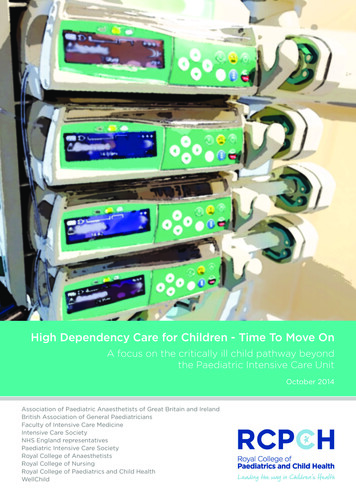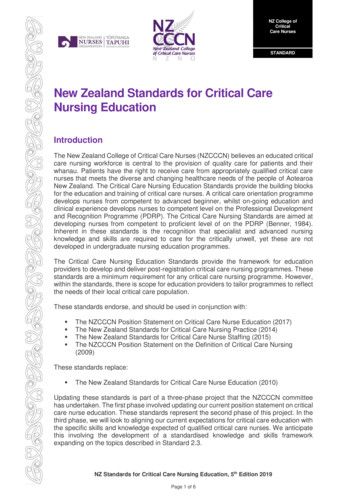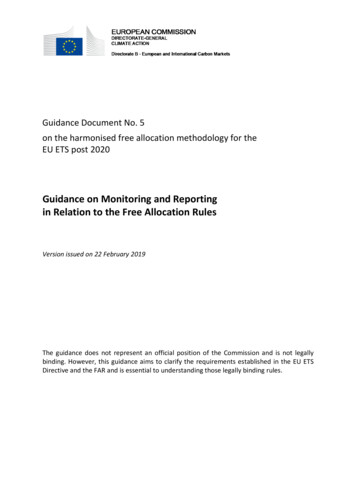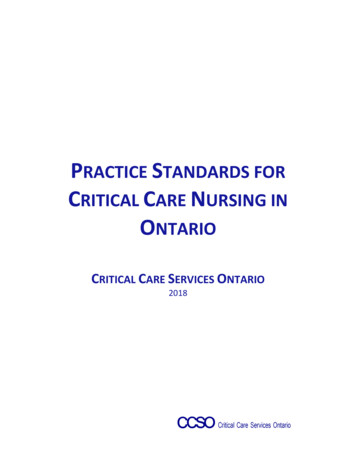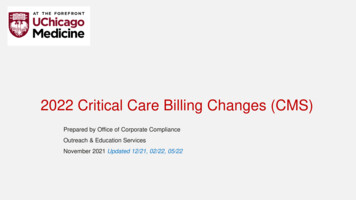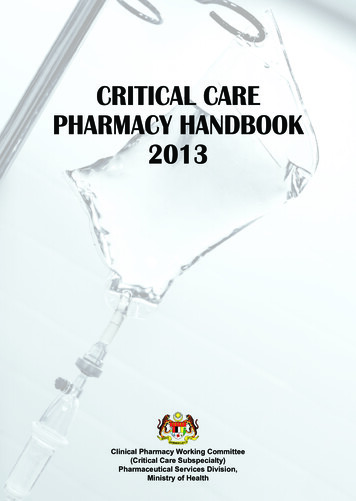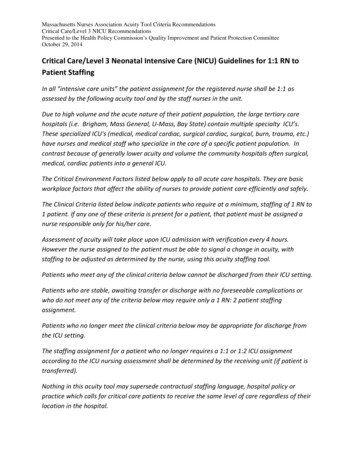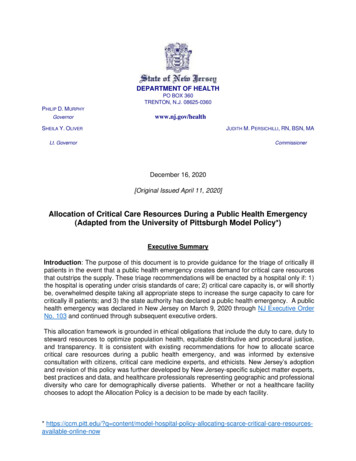
Transcription
DEPARTMENT OF HEALTHPO BOX 360TRENTON, N.J. 08625-0360PHILIP D. MURPHYGovernorwww.nj.gov/healthSHEILA Y. OLIVERJUDITH M. PERSICHILLI, RN, BSN, MALt. GovernorCommissionerDecember 16, 2020[Original Issued April 11, 2020]Allocation of Critical Care Resources During a Public Health Emergency(Adapted from the University of Pittsburgh Model Policy*)Executive SummaryIntroduction: The purpose of this document is to provide guidance for the triage of critically illpatients in the event that a public health emergency creates demand for critical care resourcesthat outstrips the supply. These triage recommendations will be enacted by a hospital only if: 1)the hospital is operating under crisis standards of care; 2) critical care capacity is, or will shortlybe, overwhelmed despite taking all appropriate steps to increase the surge capacity to care forcritically ill patients; and 3) the state authority has declared a public health emergency. A publichealth emergency was declared in New Jersey on March 9, 2020 through NJ Executive OrderNo. 103 and continued through subsequent executive orders.This allocation framework is grounded in ethical obligations that include the duty to care, duty tosteward resources to optimize population health, equitable distributive and procedural justice,and transparency. It is consistent with existing recommendations for how to allocate scarcecritical care resources during a public health emergency, and was informed by extensiveconsultation with citizens, critical care medicine experts, and ethicists. New Jersey’s adoptionand revision of this policy was further developed by New Jersey-specific subject matter experts,best practices and data, and healthcare professionals representing geographic and professionaldiversity who care for demographically diverse patients. Whether or not a healthcare facilitychooses to adopt the Allocation Policy is a decision to be made by each facility.* https://ccm.pitt.edu/?q itical-care-resourcesavailable-online-now
This document describes 1) the creation of triage teams to ensure consistent decision making;2) allocation criteria for initial allocation of critical care resources; and 3) reassessment criteria todetermine whether ongoing provision of critical care resources are justified for individual patients.Section 1. Creation of triage teams: Clinicians treating patients will not make triage decisions.Instead, each hospital will designate an acute care triage team, consisting of a physiciansupported by a nurse and administrator, who will apply the allocation framework described in thisdocument. The physician and nurse preferably should have past experience in caring for patientsin a critical care unit (including, but not limited to, an ICU, CCU, PACU, SICU, ED). Theseparation of the triage role from the clinical role is intended to promote objectivity, avoid conflictsof commitments, and minimize moral distress. The triage team will also be involved in patient orfamily appeals of triage decisions, and in collaborating with the attending physician to disclosetriage decisions to patients and families. Facilities should provide training to the triage teams andhospital/system decision-makers and health care staff in advance of implementation of adoptedallocation policies.Section 2. Allocation criteria for Intensive Care Unit/Critical Care admission: This allocationframework is based primarily on two considerations: 1) saving lives; and 2) saving life-years, bothwithin the context of ensuring meaningful access for all patients and individualized patientassessments based on objective medical knowledge. All patients who meet usual medicalindications for intensive care unit (ICU)/critical care beds and services will be assigned a priorityscore using a 1-8 scale (lower scores indicate higher likelihood of benefit from critical care),derived from 1) patients’ likelihood of surviving to hospital discharge, assessed with an objectiveand validated measure of acute physiology (e.g., the Sequential Organ Failure Assessment(SOFA) score); and 2) the likelihood of death within a few years, as outlined in Table 1, even ifthe patient survived their acute critical illness. This raw priority score may be converted to threecolor-coded priority groups (e.g., high, intermediate, and low priority) if needed to facilitatestreamlined implementation in individual hospitals. All patients will be eligible to receive criticalcare beds and services regardless of their priority score, but available critical care resources willbe allocated according to priority score, such that the availability of these services will determinehow many patients will receive critical care. Patients who are triaged to not receive ICU/criticalcare beds or services will be offered appropriate medical care, including palliative care, intensivesymptom management and psychosocial support.Note that the SOFA scoring system is not appropriate for use in children or neonates. Becausethere is no evidence-based data on how to triage children specifically for ventilator allocationbased on these clinical factors, a triage officer/team must use best clinical judgment as outlinedin appendices describing allocation policies for neonatal patients and for pediatric patients.Section 3. Reassessment for ongoing provision of critical care/ventilation: The triage teamwill conduct periodic reassessments of all patients receiving ICU/critical care services duringtimes of crisis (i.e., not merely those initially triaged under the crisis standards). The timing ofreassessments should be based on evolving understanding of typical disease trajectories and ofthe severity of the crisis. A multidimensional, individualized assessment should be used toquantify changes in patients’ conditions, such as recalculation of severity of illness scores,appraisal of new complications, and treating clinicians’ input. Patients showing improvement willcontinue to receive ICU/critical care services until the next assessment. Patients showingsubstantial clinical deterioration that portends a very low chance for survival will have critical care2
discontinued. These patients will receive medical care, including palliative care, intensivesymptom management and psychosocial support. Where available, specialist palliative careteams will provide additional support and consultation.Introduction & Ethical ConsiderationsThe purpose of this document is to provide guidance for the triage of critically ill patients in theevent that a public health emergency creates demand for critical care resources (e.g., ventilators,critical care beds) that outstrips the supply. These triage recommendations will be enacted by ahospital only if: 1) the hospital is operating under crisis standards of care; 2) critical care capacityis, or will shortly be, overwhelmed despite taking all appropriate steps to increase the surgecapacity to care for critically ill patients; and 3) the state authority has declared a public healthemergency. This allocation framework is grounded in ethical obligations that include the duty tocare, duty to steward resources to optimize population health, equitable distributive andprocedural justice, and transparency.Use of this policy is associated with state statutory and administrative law, such as P.L.2020,c.18, Department of Health Executive Directive No. 20-006, and Office of the Attorney GeneralLaw Enforcement Directive No. 2020-03.Ethical goals of the allocation framework: Consistent with accepted standards during publichealth emergencies, a goal of the allocation framework is to achieve maximum benefit forpopulations of patients, often expressed as doing the greatest good for the greatest number whilepromoting just distribution of benefits, burdens, and costs.1,2 It should be noted that this goal isdifferent from the traditional focus of medical ethics, which is centered on promoting the wellbeing of individual patients.3 In addition, the framework is designed to achieve the following:1. Create meaningful access to ICU/critical care services for all patients. All patients whoare eligible for ICU/critical care services during ordinary circumstances remain eligible forsuch services, and there are no exclusion criteria based on age, disability, or otherfactors;2. Ensure that all patients receive individualized assessments by clinicians, based on thebest available objective medical evidence;3. Ensure that no one is denied care based on stereotypes, assessments of quality of life,perceived social worth, perceived quality of life, life-table expectancy or judgments abouta person’s “worth” based on the presence or absence of disabilities, mental healthdiagnoses, or other factors;4. Ensure that discrimination based on race, age, creed, color, ethnicity, national origin,nationality or immigration status, ancestry, marital status, domestic partnership or civilunion status, sex, affectional or sexual orientation, gender identity or expression,disability status, place of residence or homelessness status, socioeconomic status,justice system involvement, or insurance status is explicitly avoided; and, to the extentpossible, those making allocation decisions should be unaware of these patientcharacteristics.No use of categorical exclusion criteria: The allocation framework described in this documentdiffers in two important ways from other allocation frameworks.3
First, it does not categorically exclude any patients who, in other circumstances, would be eligiblefor critical care resources. Instead, all patients are treated as eligible to receive critical careresources and are prioritized based on potential to benefit from those resources; the availabilityof critical care resources determines how many patients in priority groups can receive criticalcare.There are compelling reasons to not use exclusion criteria. Categorically excluding patientswould make many think that their lives are “not worth saving,” leading to justified perceptions ofdiscrimination and fear of the health system. Moreover, categorical exclusions are too rigid to beused in a dynamic crisis, when critical care resources shortages will likely surge and declineepisodically during the public health emergency. In addition, such exclusions violate afundamental principle of public health ethics: to use the means that are least restrictive toindividual liberty to accomplish the public health goal. Categorical exclusions are not necessarybecause less restrictive approaches are feasible, such as allowing all patients to be eligible andgiving priority to those most likely to benefit.Second, the allocation framework goes beyond simply attempting to maximize the number ofpatients who survive to hospital discharge, because this is a thin conception of doing the greatestgood for the greatest number.4 Instead, within the context of keeping all patients eligible, theallocation framework also attempts to increase overall survival. Some priority is given to patientswho do not have a very limited life expectancy, even if those patients survived the acute criticalillness.There is precedent for using this criterion in allocation of scarce medical resources; U.S. rules toallocate lungs for transplantation incorporate patients’ expected duration of survival aftertransplantation, not simply whether transplantation will avert impending death.5 Extensiveconsultation with citizens, ethicists, and critical care medical experts informed the principles andprocesses adopted in this document.6 New Jersey’s adoption and revision of this policy wasfurther informed by New Jersey-specific subject matter experts, best practices and data, andhealthcare professionals representing geographic and professional diversity who care fordemographically diverse patients.Additional Principles1. No institution should have to resort to limiting access to critical care resources, includingventilators, while neighboring, or regional institutions still have capacity. Implementing anallocation plan should be a last resort. Either resources or patients should be moved fromone hospital to another to ensure this is the case, regardless of patient’s insurance status,or pre-existing contracts between hospitals/systems and insurers. During a declaredpublic health emergency, the New Jersey Department of Health will monitor theavailability and demand of scarce resources, such as ventilators and ICU beds, acrossthe state and may take action regarding equitable distribution of such resources tofacilities.2. Any allocation system should be equitable (fair) and serve to maximize lives and lifeyears saved (utility). However, considerations of quality-adjusted life years (QALYs) isnot appropriate, and could lead to subjective, discriminatory decisions, particularly relatedto those with disabilities.3. Facilities should provide training to hospital/system decision-makers and health care staffin advance of implementation of adopted allocation policies. Services to attend to providermoral distress should be strengthened.4
4. Nothing in this policy shall abrogate the patients’ autonomy to opt-out from (refuse) theuse of scarce resources (e.g. through use of Practitioner Orders of Life SustainingTreatment (POLST)or other shared decision-making tools). Patients admitted to generalhospitals also retain rights enumerated in N.J.S.A. 26:2H-12.8, including rights pertainingto nondiscrimination, informed consent, facility transfer, and confidentiality.5. If a patient presents to a hospital and has personal medical equipment, such as aventilator, that equipment will not be confiscated or used for any other patient.This document describes 1) the creation of triage teams to ensure consistent decision making;2) allocation criteria for initial allocation of critical care resources; and 3) reassessment criteria todetermine whether ongoing provision of scarce critical care resources are justified for individualpatients.Section 1. Creation of triage teamsThe purpose of this section is to provide guidance to create a triage team at each hospital whoseresponsibility is to implement the allocation framework described in Sections 2 and 3. It isimportant to emphasize that clinicians treating patients will not make triage decisions. Instead,each hospital will designate a critical care resources triage team, consisting of at least onephysician supported by at least one nurse and at least one administrator, who will apply theallocation framework described in this document. These decisions are grounded in public healthethics, not clinical ethics, and therefore a triage team with expertise in the allocation frameworkshould make allocation decisions. The separation of the triage role from the clinical role isintended to enhance objectivity, avoid conflicts of commitments, and minimize moral distress.Lead Triage OfficersA group of triage officer should be appointed at each hospital facility. Preferable qualities of triageofficers include being a physician with established expertise in the management of critically illpatients (e.g. past experience in caring for patients in a critical care unit including, but not limitedto, an ICU, CCU, PACU, SICU, ED), strong leadership ability, effective communication andconflict resolution skills, and bioethics expertise where possible. To the extent possible, the leadtriage officers shall adequately represent the diversity of the patient populations served by thefacility.Lead triage officers will oversee the triage process, assess all patients, assign a level of priorityfor each patient, communicate with treating physicians, and direct attention to the highest-prioritypatients. Each triage officer is expected to make decisions with the team according to theallocation framework described below, which is designed to benefit the greatest number ofpatients, even though these decisions may not necessarily be best for some individual patients.To optimize effective functioning in a crisis, the triage officer should ideally be well-prepared andtrained in advance by means of disaster drills or exercises. The triage officer has theresponsibility and authority to apply the principles and processes of this document to makedecisions about which patients will receive the highest priority for receiving critical care. She/heis also empowered to make decisions with the team regarding reallocation of critical careresources that have previously been allocated to patients by using the principles and processesin this document. In making these decisions, the triage officer and team should not use principlesor beliefs that are not included in this document.5
So that the burden is fairly distributed, the lead triage officers and team members will benominated by the chairs/directors of the clinical departments that provide care to critically illpatients. The Chief Medical Officer and the individual responsible for emergency managementshould approve all nominees. A roster of approved triage officers and team members should bemaintained that is large enough to ensure that they will be available on short notice at all times,and that they will have sufficient rest periods between shifts.Triage TeamIn addition to the lead triage officer, the triage team should also consist of a nurse preferably withpast experience in caring for patients in a critical care unit including, but not limited to, an ICU,CCU, PACU, SICU, ED) (even if no longer clinically active), and one administrator who willconduct data-gathering activities, documentation and record keeping, and liaise with the hospitalCommand Center or bed management . The administrator must be provided with appropriatecomputer and IT support to maintain updated databases of patient priority levels and scarceresource usage (total numbers, location, and type). To the extent possible, the triage team shallinclude members who adequately represent the diversity of the patient populations served by thefacility The role of triage team members is to provide information to the lead triage officer andhelp facilitate, support, and document the decision-making process. A representative fromhospital administration should also be linked to the team, in order to supervise maintenance ofaccurate records of triage scores and to serve as a liaison with hospital leadership.The lead triage officer and team members should function in shifts lasting no longer than 13hours (to enable 30 minutes of overlap and handoffs on each end). Therefore, there should betwo shifts per day to fully staff the triage function. All documentation related to triage teamdecisions, communication with patients and families, appeals, and supporting documentationshould be maintained in patient records and reported daily to appropriate hospital leadership andincident command. Information about the implementation of this policy may be requested fromfacilities by the New Jersey Department of Health in its oversight functions and to inform anyfuture revisions of this policy.Facilities should provide training on the allocation policy to the triage teams, hospital/systemdecision-makers and health care staff in advance of implementation of adopted allocationpolicies. To the extent possible, the training should include basic bioethics principles and implicitbias concepts.Triage MechanismThe lead triage officer and her/his team will use the allocation framework, outlined in Section 2below, to determine priority scores of all patients eligible to receive the scarce critical careresource. For patients already being supported by the scarce resource, the evaluation will includereassessment to evaluate for clinical improvement or worsening at pre-specified intervals, asoutlined in Section 3 below. The lead triage officer will review the comprehensive list of priorityscores for all patients and will communicate with the clinical teams immediately after a decisionis made regarding allocation or reallocation of a critical care resource. As the triage process isconducted, the triage team shall be mindful of the role that implicit bias may play in decisionmaking.Communication of triage decisions to patients and familiesAlthough the authority for triage decisions rests with the lead triage officer and his/her team, thereare several potential strategies to disclose triage decisions to patients and families.6
Communicating triage decisions to patients and/or their next of kin is a required component of afair allocation process that provides respect for persons.7 The lead triage officer should firstinform the affected patient’s attending physician about the triage decision. Those two physicians(the lead triage officer and the patient’s attending physician) should collaboratively determine thebest approach to inform the individual patient and family of the triage decision. Options for whoshould communicate the triage decision include: 1) solely the attending physician; 2) solely thelead triage officer; or 3) a collaborative effort between the attending physician and lead triageofficer.Regardless of the approach, special consideration shouldbe made to ensure thatcommunication of triage decisions is done in a competent and sensitive manner, with racially,ethnically, culturally and linguistically diverse team members available to assist in thesecommunications if possible, and specialized assistive technology, interpretative services, orother reasonable accommodations available for patients and families who require or request it.The best approach of the three methods outlined above for communication of triage decisionswill depend on a variety of case-specific factors, including the dynamics of the individual doctorpatient-family relationship and the preferences of the attending physician. If the attendingphysician is comfortable with undertaking this decision, such approach is beneficial because thecommunication regarding triage will bridge naturally to a conveyance of prognosis, which is aresponsibility of bedside physicians, and because it may limit the number of clinicians exposedto a circulating pathogen. However, The third (collaborative) approach may also be beneficial incertain circumstances because it may lessen moral distress for individual clinicians and mayaugment trust in the process, but these benefits must be balanced against the risk of greaterclinician exposure. Under this approach, the attending physician would first explain the severityof the patient’s condition in an emotionally supportive way, and then the lead triage officer wouldexplain the implications of those facts in terms of the triage decision. The lead triage officer wouldalso emphasize that the triage decision was not made by the attending physician alone but wasinstead made collaboratively by both physicians after careful consideration of the extraordinaryemergency circumstances , and reflects a public health decision. Regardless of whocommunicates the decision, it may useful to explain the medical factors that informed thedecision, as well as the factors that were not relevant (e.g., race, ethnicity, gender, insurancestatus, perceptions of social worth, immigration status, among others). If resources permit,palliative care clinicians or social workers should be present or available to provide ongoingemotional support to the patient and family.Appeals process for individual triage decisionsAll patients and authorized healthcare representatives who were not allocated critical careresources by the triage process must be advised of their right to appeal these decisions. It ispossible that patients, families, or clinicians will challenge individual triage decisions. This appealmechanism is grounded in principles of fairness and transparency.Procedural fairness requires the availability of an appeals mechanism to resolve such disputes.On practical grounds, different appeals mechanisms are needed for the initial decision to allocatea scarce resource among individuals, none of whom are currently using the resource, and thedecision whether to withdraw a scarce resource from a patient who is not clearly benefiting fromthat resource. This is because initial triage decisions for patients awaiting the critical careresource will likely be made in highly time-pressured circumstances. Therefore, an appeal will7
need to be adjudicated in real time to be operationally feasible. The only permissible appeals ofthe initial triage decision are appeals based on a claim that an error was made by the triage teamin the calculation of the priority score or use/non-use of a tiebreaker (as detailed in Section 2).The process of evaluating the appeal should include the triage team verifying the accuracy of thepriority score calculation by recalculating it. The treating clinician or triage officer should beprepared to explain the calculation to the patient or family on request.Decisions to withdraw a scarce resource such as mechanical ventilation from a patient who isalready receiving it may cause heightened moral concern. Furthermore, such decisions dependmore on clinical judgment than on initial allocation decisions. Therefore, withdrawal orreallocation of critical care beds or services requires a robust process for appealing decisions.Elements of this appeals process should include the following factors: the individuals appealing the triage decision should explain to the lead triage officer thegrounds for their appeal. Appeals based on an objection to the overall allocationframework should not be granted;the triage team should explain the grounds for the triage decision that was made;appeals based in considerations other than disagreement with the allocation frameworkshould immediately be brought to a Triage Review Committee that is independent of thelead triage officer/team and of the patient’s care team (see below for recommendedcomposition of this body);the appeals process must be expedited so that it does not harm patients who are in thequeue for scarce critical care resources currently being used by the patient who is thesubject of the appeal;the decision of the Triage Review Committee or subcommittee for a given hospital/systemwill be final; andPeriodically, the Triage Review Committee should retrospectively evaluate whether thereview process is consistent with effective, fair, and timely application of the allocationframework.The Triage Review Committee should be made up of at least three individuals, recruited from thefollowing groups or offices: Chief Medical Officer or designee, Chief Nursing Officer or otherNursing leadership, Legal Counsel, a hospital Ethics Committee or Consult Service, members ofan institution’s ethics faculty, and/or an off-duty triage officer. Three committee members areneeded for a quorum to render a decision, using a simple majority vote. The process can happenby telephone or in person, and the outcome will be promptly communicated to whomever broughtthe appeal.Section 2. Allocation process for ICU/CRITICAL CARE admissionThe purpose of this section is to describe the allocation framework that should be used to makeinitial triage decisions for patients who present with illnesses that typically require critical careresources (i.e., illnesses that cannot be managed on a hospital ward in that hospital). A scoringsystem is used that applies to all patients presenting with critical illness, not merely those withthe disease or disorders that have caused the public health emergency. For example, in thesetting of a severe pandemic, those patients with respiratory failure from illnesses not caused bythe pandemic illness will also be subject to the allocation framework. This process involves twosteps, detailed below:8
1. Calculating each patient’s priority score based on the multi-principle allocationframework;2. Determining each day how many patients in priority groups will receive access to criticalcare interventions.First responders and bedside clinicians should perform the immediate stabilization of any patientin need of critical care, as they would under normal circumstances. Along with stabilization,temporary ventilatory support may be offered to allow the triage officer to assess the patient forcritical resource allocation. Every effort should be made to complete the initial triage assessmentwithin 90 minutes of the recognition of the likely need for critical care resources.STEP 1: Calculate each patient’s priority score using the multi-principle allocationframework.This allocation framework is based primarily on two considerations: 1) saving lives; and 2) savinglife-years, both within the context of ensuring meaningful access for all patients and individualizedpatient assessments based on objective medical knowledge. Patients who are more likely tosurvive with intensive/critical care are prioritized over patients who are less likely to survive withintensive care/critical care. Patients who, because of underlying conditions are not likely to diewithin 5 years are given priority over those who have such advanced conditions that they arelikely to die within 5 years, even if they were to survive their acute critical illness.As summarized in Table 1, the Sequential Organ Failure Assessment (SOFA) score (or analternate, validated, objective measure of probability of survival to hospital discharge) is used todetermine patients’ prognoses for hospital survival. The presence of conditions in such anadvanced state that death is likely within a relatively short period of time is used to characterizepatients’ longer-term prognosis. Based on consultation with experts in disability rights andphysical medicine and rehabilitation, we have intentionally not included a list of exampleconditions associated with death likely in less than 1 year and 5 years. The rationale for this isthat such lists run the risk of being applied as blanket judgments, rather than in the context ofindividualized assessments by clinicians, based on the best available objective medicalevidence.Table
2 This document describes 1) the creation of triage teams to ensure consistent decision making; 2) allocation criteria for initial allocation of critical care resources; and 3) reassessment criteria to

![[Title to come] DSP Dynamic Asset Allocation Fund](/img/24/dsp-dynamic-asset-allocation-fund.jpg)
